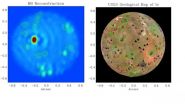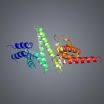(Press-News.org) Alzheimer's disease (AD) is a neurodegenerative condition that strikes at the heart of what makes us human: the ability to think, to feel, to remember and to communicate with those around us. The tragedy is compounded by the fact that there is currently no cure, no treatment, and no diagnostic method capable of identifying Alzheimer's at its early stages.
A ground-breaking study has now, for the first time anywhere, characterized early-stage changes that occur inside individual, Alzheimer's-affected cells in the intact brain. Remarkably, the study indicates that even if only a small number of cells is affected, the result is a reduction of electrical activity throughout the cerebral cortex - the area of the brain that serves as the center of higher mental function and cognition.
The researchers - Drs. Edward Stern and Dana Cohen of Bar-Ilan University and Dr. Tara Spires-Jones of the University of Edinburgh - published their findings in the academic journal Neuron on February 19th, 2015.
A Tangled Web
Dr. Edward Stern, the lead author of the study, is a member of Bar-Ilan University's Gonda (Goldschmied) Multidisciplinary Brain Research Center, and also holds an appointment at the MassGeneral Institute for Neurodegenerative Disease at Massachusetts General Hospital in the United States. He explains that the study's dramatic results are due, in part, to the scientists' decision to focus on a seldom-studied brain cell pathology known as "tangles".
"Alzheimer's disease is associated with three pathologies: cell death, extra-cellular build-up of amyloid plaques, and tangles - the abnormal twisting of the cellular filaments which hold the neuron in its proper shape," Stern says, adding that tangles are caused by an aberrant form of a protein known as tau.
"While it was already known that pathological tau is associated with dementia, ours is the first study to reveal the tau-linked changes in cell- and network-based activity that underlies neurodegeneration. Significantly, we found that if even a small number of cells have tangles, this amplifies into a devastating effect across the entire network, characterized by long latencies between spikes of inter-neuron communication, as well as a reduction in the overall level of synaptic activity."
Recording Network-Based "Conversations" in the Intact Brain
The researcher's observations were made possible through the use of a technique that allowed them to position electrodes inside individual cells in the intact anaesthetized brains of transgenic mice. Studying these mice - genetically altered to produce the tangle-triggering abnormal tau protein - the scientists measured spontaneous sub-threshold fluctuation of electrical activity. They also observed how neuronal activity patterns change in response to stimulation.
Experiments performed by Dr. Noa Menkes-Caspi, at the time a doctoral candidate in Stern's lab, demonstrated that pathological tau disrupts the activity of single cells as well as intra-cellular communication in the neocortex. This phenomenon was observed prior to any significant cell death, at a time when only a small fraction of the neurons displayed fully-developed tangles.
According to Stern, these results indicate that Alzheimer's symptoms - long suspected to be caused by the extra-cellular build-up of amyloid-beta, are also caused by the abnormal accumulation of tau that afflicts individual cells. By reducing the rate at which individual neurons fire, tangles act to suppress synaptic activity in the wider neocortical network, leading to reduced cognitive function. Stern suggests that the two pathologies combine with devastating effect to change the neuronal activity patterns in the brain, causing Alzheimer's disease symptoms.
A Timely Message with Medical Potential
Stern points out that this study represents the first time that an abnormality in neural physiology has been causally linked to changes in brain behavior on the network level. He states that this data may eventually point the way toward an elusive goal of clinical medicine: a method for positively identifying Alzheimer's onset, before it's too late.
"Now that we have characterized patterns of neocortical electrical activity in the presence of tangle-afflicted cells and amyloid-beta affected brains, it may be possible to screen for these patterns with EEG," he says, referring to electroencephalogram, a non-invasive technique commonly used to identify epilepsy and other brain disorders. "This could someday form the basis of early AD diagnosis."
Stern also sees these findings as an important step toward the longer-term goal of effective Alzheimer's treatment.
"The key is to compare pathological to normal neurons, and identify ways in which abnormal neural activity might be reversed," he says. "Since a change in brain cell activity is what causes disease symptoms, a clearer understanding of abnormal neural physiology may bring us closer to what we all want, and what the world needs - a treatment for Alzheimer's disease."
INFORMATION:
How many websites have you clicked on recently that haven't converted their format to mobile, frustrating your efforts to get the information you need in an effective and timely way?
Now researchers from Northwestern University have unearthed some provocative facts on how consumers utilize their mobile devices to buy groceries. With the global market for smartphones predicted to reach two billion by 2016, their findings should convince retailers planning marketing strategies and advertising campaigns that they need to pay attention to mobile.
In "On the Go: How Mobile ...
PITTSBURGH (May 5, 2015) ... For decades, robots have advanced the efficiency of human activity. Typically, however, robots are formed from bulky, stiff materials and require connections to external power sources; these features limit their dexterity and mobility. But what if a new material would allow for development of a "soft robot" that could reconfigure its own shape and move using its own internally generated power?
By developing a new computational model, researchers at the University of Pittsburgh's Swanson School of Engineering have designed a synthetic polymer ...
Treating gum disease reduced symptoms of prostate inflammation, called prostatitis, report researchers from Case Western Reserve University School of Dental Medicine and the Departments of Urology and Pathology at University Hospitals Case Medical Center.
Previous studies have found a link between gum disease and prostatitis, a disease that inflames the gland that produces semen. Inflammation can make urination difficult.
"This study shows that if we treat the gum disease, it can improve the symptoms of prostatitis and the quality of life for those who have the disease," ...
Although the use of cannabis as a medical drug is currently booming (Dtsch Arztebl Int 2012; 109: 495-501), we should not forget that leisure time consumption--for example, smoking weed--can cause acute and chronic harms. These include panic attacks, impaired coordination of movement, and nausea, as Eva Hoch and colleagues show in a topical review article in Deutsches Ärzteblatt International (Dtsch Arztebl Int 2015; 112: 271-8). The symptoms depend on a patient's age, the amount of the drug consumed, and the frequency of drug use. It also matters in which form the ...
(Winston-Salem, N.C. - May 5, 2015) - Researchers from Wake Forest University and the University of Utah are the first to successfully fabricate halide organic-inorganic hybrid perovskite field-effect transistors and measure their electrical characteristics at room temperature.
"We designed the structure of these field-effect transistors that allowed us to achieve electrostatic gating of these materials and determine directly their electrical properties," said lead author, Oana Jurchescu, an assistant professor of physics at Wake Forest. "Then we fabricated these transistors ...
This news release is available in German.
With the first detailed observations of a lava lake on a moon of Jupiter, the Large Binocular Telescope Observatory in Arizona places itself as the forerunner of the next generation of Extremely Large Telescopes. The applied high-resolution imaging methods were developed by an international research team including scientists from the Max Planck Institute for Radio Astronomy in Bonn and the Max Planck Institute for Astronomy in Heidelberg.
Io, the innermost of the four moons of Jupiter discovered by Galileo in January ...
This news release is available in German.
Overturning cars, flying missiles, and airplanes speeding across the screen -- on modern computers, 3D objects can be calculated in a flash. However, many surfaces still look unnatural. Whether it is skin, stone or wax -- on the computer screen, all materials look alike, as if the objects had all been cut out of the same kind of opaque material. This is about to change: TU Wien (Vienna), the University of Zaragoza and the video game company Activision-Blizzard have developed a new mathematical method which makes surfaces appear ...
Our view of what makes us happy has changed markedly since 1938.
That is the conclusion of the psychologist Sandie McHugh from the Univeristy of Bolton who has recreated a famous study of happiness conducted in Bolton in 1938. She will present her study today, Tuesday 5 May 2015, to the Annual Conference of the British Psychological Society in Liverpool.
In 1938 Mass Observation placed an advertisement in the the Bolton Evening News asking readers to answer the question 'What is happiness?'. A total of 226 people sent letters in reply, and they were asked to help compile ...
Ribosomes are vital to the function of all living cells. Using the genetic information from RNA, these large molecular complexes build proteins by linking amino acids together in a specific order. Scientists have known for more than half a century that these cellular machines are themselves made up of about 80 different proteins, called ribosomal proteins, along with several RNA molecules and that these components are added in a particular sequence to construct new ribosomes, but no one has known the mechanism that controls that process.
Now researchers from Caltech and ...
AUSTIN, Texas -- Researchers in the Cockrell School of Engineering at The University of Texas at Austin have developed a centimeter-accurate GPS-based positioning system that could revolutionize geolocation on virtual reality headsets, cellphones and other technologies, making global positioning and orientation far more precise than what is currently available on a mobile device.
The researchers' new system could allow unmanned aerial vehicles to deliver packages to a specific spot on a consumer's back porch, enable collision avoidance technologies on cars and allow virtual ...


